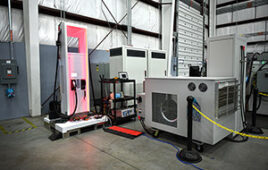NREL Solar Research Garners Two Prestigious R&D 100 Awards
An etching technique that makes silicon wafers more efficient and a mammoth power generator that sets a new standard for the production of solar energy – both developed at the U.S. Department of Energy’s (DOE) National Renewable Energy Laboratory – have been named among this year’s most significant innovations by Research & Development (R&D) Magazine.
The two prestigious awards, known in the research and development community as “the Oscars of Innovation,” brings to 47 the number of R&D 100 awards that NREL has won since 1969, when the magazine launched the awards for the best new technologies from around the world.
“I want to congratulate all of this year’s winners on their awards and to thank them for their work,” Energy Secretary Steven Chu said. “The large number of winners from the Department of Energy’s national labs every year is a clear sign that our labs are doing some of the most innovative research in the world. This work benefits us all by enhancing America’s competitiveness, ensuring our security, providing new energy solutions, and expanding the frontiers of our knowledge. Our national labs are truly national treasures, and it is wonderful to see their work recognized once again.”
Both R&D 100 awards recognize research at NREL’s National Center for Photovoltaics.
“These two technologies will play an important part in advancing solar energy’s competitiveness and enhancing the availability of solar power in the United States and around the world,” NREL Director Dan Arvizu said.
The “Black Silicon” Nanocatalytic Wet-Chemical Etch emerged from work by NREL photovoltaic researchers that demonstrated that “black silicon” solar cells, which have been chemically etched to appear black, can better absorb the sun’s energy. The inexpensive, one-step method reduces light reflection from silicon wafers to less than 2 percent, and promises to reduce manufacturing production cost and capital expense.
Any photons reflected from the surface of a solar cell are wasted. To reduce reflected sunlight and increase cell efficiency, NREL scientists invented the antireflection process that turns silicon wafers black so they absorb 98 percent of solar radiation.
Today’s solar cells absorb about 95 percent of the sun’s radiation, so the new high-absorption black silicon process could make solar cells some 3 percent more efficient. That should reduce the cost of energy delivered over the life of a silicon PV array by about 2.5 percent.
NREL’s Howard Branz is the principal scientist for the black-silicon etch technology, working with postdoctoral researcher Hao-Chih Yuan, research scientist Matthew R. Page, senior research technician Vernon E. Yost, senior scientist Scott Ward and engineer Anna Duda.
The Amonix 7700 Solar Power Generator was developed in a partnership between NREL and Amonix. It is a highly concentrated, highly efficient bulk power generator that produces 40 percent more energy than conventional fixed photovoltaic panels. The 53-kilowatt photovoltaic power generator is based on the MegaModule, a turnkey unit pairing a durable Amonix Fresnel lens with high-efficiency multi-junction solar cells.
The Amonix 7700 is the first terrestrial photovoltaic system capable of converting one-fourth of the sun’s energy into usable electricity. It produces “more power per tower” by using record-efficient solar cells, tried-and-true concentrator Fresnel lenses and smart controller and tracker systems.
It is expected to be a game-changer, sharply increasing the viability of PV-generated electricity to compete with fossil fuels. At 53 kilowatts of electricity generation per unit, it has the highest capacity in the industry, and it can be installed in days, rather than the weeks or months typical of large-scale concentrated photovoltaic arrays.
Martha Symko-Davies, manager of NREL’s PV Technology Incubator, led the NREL effort along with Amonix’s Vahan Garboushian, Robert McConnell and Robert Gordon.
More on NREL’s photovoltaics research can be found at http://www.nrel.gov/pv/.
NREL is the U.S. Department of Energy’s primary national laboratory for renewable energy and energy efficiency research and development. NREL is operated for DOE by the Alliance for Sustainable Energy, LLC.
###
Visit NREL online at www.nrel.gov




